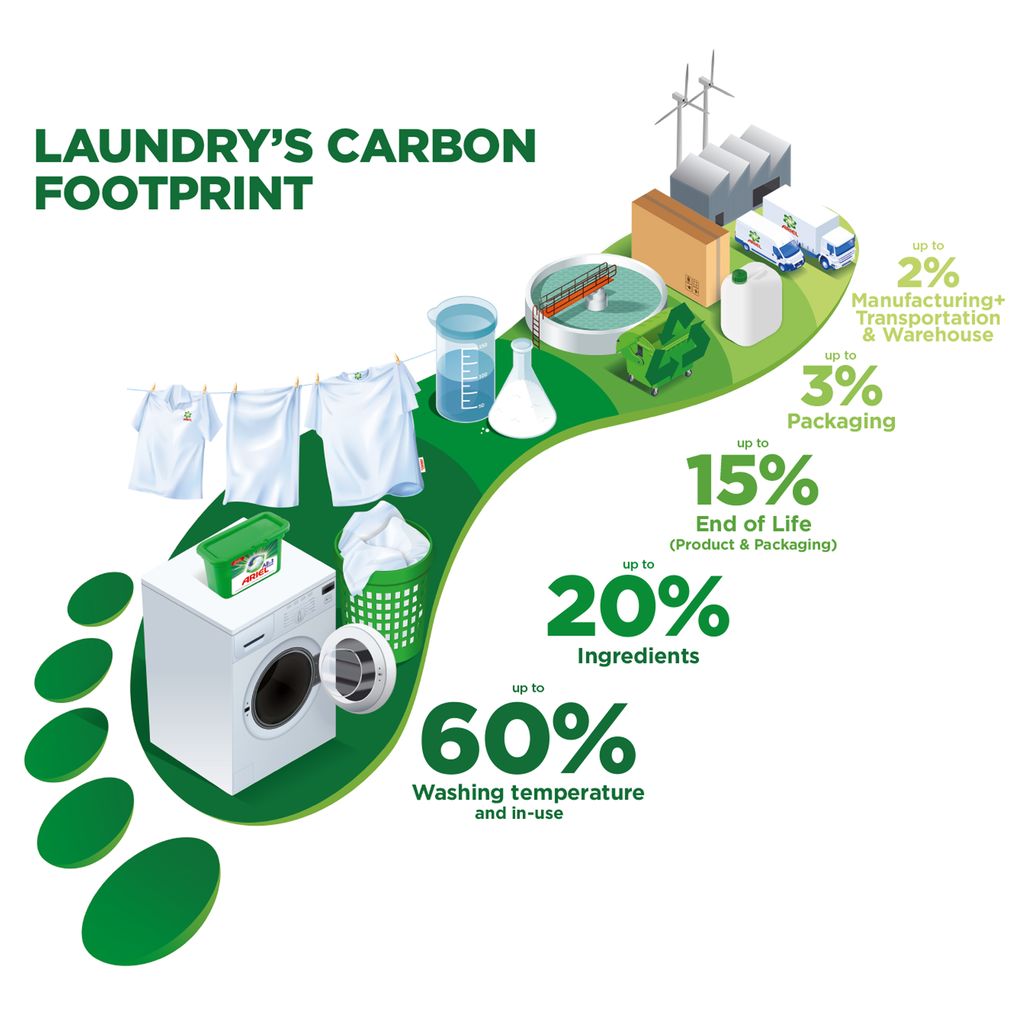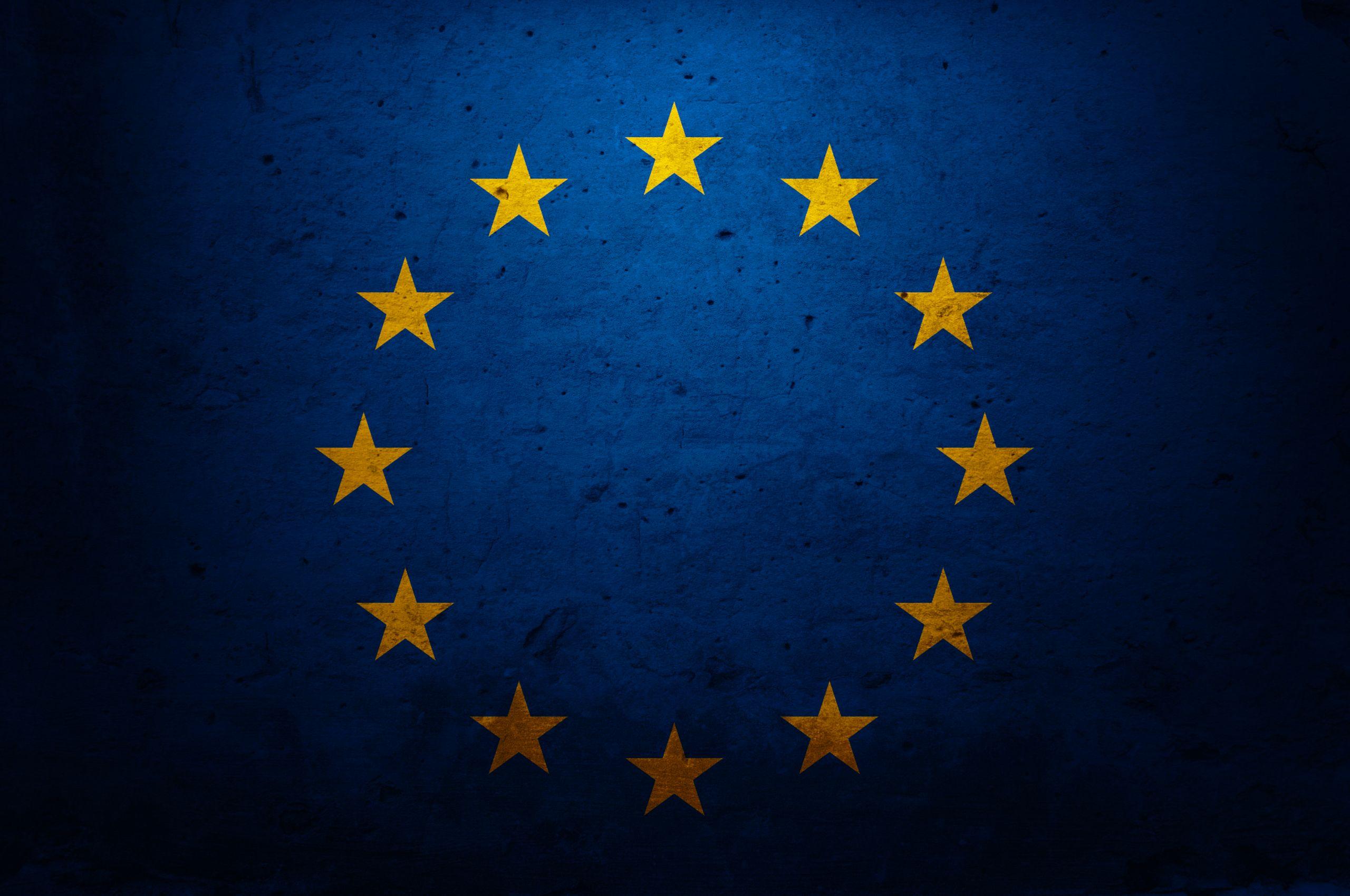If there is one thing that can be relied on in life, it’s that there will always be a pile of laundry ready to be washed, dried, and put away. We may spend time every day doing household chores, but rarely do we stop and think about the impact of our laundry routines on our own carbon footprints. Even when we do, we tend to think that any change in routine won’t make much of a difference. But the reality is that if we all apply small changes to our day-to-day activities at home – like laundry – together we can have an enormous, large-scale impact.
On average in Europe, 60 percent of the carbon footprint from laundry comes from the in-use phase, mainly due to heating of the water1, according to decades of research and life cycle assessments on the environmental impact across the entire laundry value chain – from detergent ingredients, to manufacturing, use and disposal.
The sourcing and production of ingredients accounts for up to one fifth of the life cycle carbon footprint, while packaging accounts for just 3 percent. The manufacturing, transportation, distribution and storage of detergents combined are responsible for less than 2 percent. This shows that decarbonizing laundry requires a combined effort from businesses, regulators and consumers.
In Europe, on average about 60 percent of the carbon footprint from laundry comes from the in-use phase, mainly due to heating of the water.
A small change with a big impact
Small, consistent changes can make a big, positive difference for sustainability. Yet, small daily habits can also be the most difficult ones to break. Most of us automatically just wash our laundry on a warm setting. In fact, washing at lower temperatures is a pivotal driver to improve the overall sustainability profile of the laundry process, according to life cycle assessment studies2 across the industry, and past programs by the International Association for Soaps, Detergents and Maintenance Products such as the I Prefer 30° campaign.
For instance, doing laundry at 20 degrees Celsius emits a third less CO2 than at 60 degrees. When European consumers reduce their wash temperature from 40 degrees to 30 degrees it can save up to 35 percent of CO2 emissions. If everyone in Europe did this, we could save 3.5 million tons of CO2 per year — the equivalent of taking roughly 2 million cars off the road3. Washing at colder temperatures also helps take care of clothes. A 20-degree quick cycle can help clothes last up to four times longer than washing on a 40-degree cotton cycle.
So every degree makes a difference. Making a habit of turning down the washing machine temperature dial is the single biggest way to reduce the environmental impact of each wash load. But why are so many of us still washing on warm cycles? Because many are worried about losing the cleaning performance. Does washing colder mean a compromise on clean? Well, it doesn’t have to.
Making a habit of turning down the washing machine temperature dial is the single biggest way to reduce the environmental impact of each wash load.
Sustainability supported by performance
A cold wash is the ultimate torture test for laundry products. Performance at low temperatures is key to avoiding compensating behaviors such as rewashing clothes, pre-treating or overdosing, which consumers resort to when a product fails to give laundry a sparkling clean. Consumer studies show that when given a poor-performing product, people lose confidence in colder washing and start over-compensating. Ultimately, the negative impact of these behaviors may outweigh any environmental benefits of switching to a detergent with fewer ingredients that might not clean as well.
Detergent brands have the responsibility to provide science-based product design that delivers superior performance, even at colder temperatures. It’s not just a nice-to-have. P&G’s Ariel uses innovative bio-science and learnings from nature to design high-quality detergents that achieve more using less and deliver superior cleaning in cold temperatures. This is done with low-carbon ingredients that are often found in nature, such as enzymes. Enzymes are natural catalysts and, in the same way that they clean corals in the ocean, they can provide a hygienic clean in cold cycles.
But even with well-performing formulas, changing habits can be tough. It requires an education for consumers of the benefits of washing in cold. That is why partnerships with credible organizations and campaigns, like past campaigns by Ariel with the World Wide Fund for Nature, are critical in encouraging consumers to wash colder and achieve Ariel’s ambition of lowering the average European temperature by 5 degrees by 2025, compared to 2020.
Decarbonize every step of the way
While brands need to enable and encourage consumers to turn down wash temperatures – addressing the 60 percent portion of laundry’s carbon footprint – they must also tackle the other 40 percent of the impact. From embracing the use of lower carbon ingredients, to reducing plastic and optimizing supply chains.
Ariel, and P&G’s other detergent and cleaning brands, will play a pivotal role in helping the company achieve its targets to reduce indirect Scope 3 emissions by 40 percent by 2030 and Scope 1 and 2 emissions across operations and supply chains to net zero by 2040. Achieving these goals mean innovating to use more carbon-efficient ingredients, shifting long-haul transit to less emissions-intensive trains and boats, using less and – when it must be used – better plastic, and driving circular packaging solutions.
It is critical that emerging regulations under the Green Deal enable innovation, considering what matters for sustainability in this sector.
Laundry – like every other industry – has a role to play in improving and enabling sustainability. This can only come through sustainable innovation. It is critical that emerging regulations under the Green Deal enable this innovation, considering what matters for sustainability in this sector. Within science-based frameworks everyone involved in the process, from sourcing and manufacturing all the way to each person in their laundry routine, can make a positive contribution to sustainability, based on designing for and choosing to wash in cold.
References
1 Simplified LCA break-down, based on European average
2 https://enveurope.springeropen.com/articles/10.1186/s12302-015-0055-4 and https://www.avnir.org/documentation/bdd/sg/Ariel%20Actif%20a%20Froid%20LCA%20report%20Nov%202006_0.pdf
3 Stat taken from: https://us.pg.com/blogs/pg-sustainability-tide-ariel-cold-water-wash/





